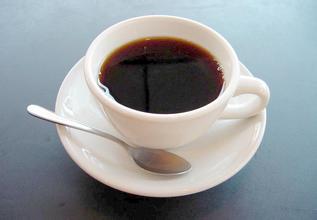How does the coffee taste sour and taste?
(1) Acid (acidy)
The primary taste associated with "sweet" compounds in coffee. The combination of acid and sugar in the coffee increases the sweetness of the coffee as a whole. Washed Arabica coffee growing above 4000 feet, such as Columbia Premium Coffee, has this characteristic. Sour coffee tastes from spicy (nippy) to spicy (piquant), felt by the tip of the tongue.
(2) acrid
Secondary taste associated with "soury". When the coffee has just been inhaled into the mouth, it has a very irritating sour taste felt at the back of the tongue. As the coffee cools down, the irritating taste is replaced by the sour taste. The bitter and spicy taste is due to the fact that the percentage of acid in coffee is higher than the average. In the process of mixing salt with acid, the acid enhances the salty taste. This is the characteristic of dry-processed Brazilian Rio coffee.
(3) Alkali (alkaline)
Secondary flavor associated with "pungent". Deep-roasted coffee often has this characteristic. The back of the tongue will feel dry and scratched. Alkali and carbolic acid compounds are the cause of this taste, and they also have a not-so-uncomfortable bitter taste.
(4) dry (astringent)
Secondary flavor associated with "sharp". When I first inhaled this coffee, I felt salty and tightened on the tip of my tongue. In the process of tasting, the acid makes the coffee which is already mainly salty more salty. This is the characteristic of Indonesian dry-treated Rob coffee.
(5) basic flavor (basic tastes)
The basic taste includes sweet, sour, salty and bitter. It has the taste characteristics of sucrose, tartar, sodium chloride and quinine respectively.
(6) bitter
It belongs to one of the basic flavors. It has the taste characteristics of quinine, caffeine and some other alkaloid solutions, which can be sensed by the outline papillae at the back of the tongue.
(7) Hand
The primary taste associated with "salty" compounds. The sugar and salt in the coffee reduce the overall salinity of the coffee water. Washed Arabica coffee growing below 2000 feet usually has this characteristic. For example, the washed Arabica coffee grown in the lowlands of El Salvador is an example. The taste of light coffee ranges from "soft" to neutral, mainly from the edge of the tongue.
(8) caustic
It belongs to secondary taste and is related to "harsh". When coffee is inhaled into the mouth, the back edge of the tongue will feel burning and sour. When the coffee cools down, the burning and sour taste are replaced by a rather uncomfortable sour taste. Due to the loss or lack of sugar in raw coffee beans, bitterness takes the place of sweetness in the basic flavor mixing process. This is the characteristic of dry-processed liberica coffee.
(9) creosote creosoty
Secondary flavor associated with "pungent". It is a typical taste of deep-roasted coffee. When coffee is inhaled into the mouth, there is an obvious scratching on the back of the tongue. When coffee is drunk, it will have a strong aftertaste (aftertaste) in the mouth.
Coffee bean fiber combines pyrimidine and carbonic acid produced by dry burning to produce a burning sensation and oil smell.
(10) fine (delicate)
Secondary flavor associated with "mellow". You can feel a slight sweetness when the coffee passes through the tip of the tongue. The sugar content of coffee is combined with salt (which is highly unlikely) to produce sweetness, but this sweetness is easily destroyed by other flavors. This is a typical feature of washed Arabica coffee in Papua New Guinea.
(11) hard
Secondary taste associated with "soury". When coffee is inhaled into the mouth, there is a tingling and sour sensation on the back edge of the tongue. When the coffee cools down, these two feelings will be replaced by a stronger sour taste. When the coffee fruit is harvested or dried, once the pulp of the coffee is bruised, the sugar is converted to acid under the action of enzyme, forming a strong flavor. Brazil's Parana coffee has this characteristic.
(12) Flavor (medicinal)
Secondary taste associated with "harsh". When coffee is inhaled into the mouth, there is a sharp sour feeling on the back edge of the tongue. When the coffee cools, the taste is replaced by a chemical similar to iodine. This flavor occurs because the alkaloids in coffee increase the acidity of caffeic acid and have nothing to do with sugar. Coffee fruit tastes like this when it is infected by diseases and insect pests.
(13) Glycol (mellow)
A primary taste associated with sweet compounds. The fusion of salt and sugar in coffee increases the overall sweetness of coffee. This is the origin of the smell of glycol. Washed Arabica coffee, which grows below 4000 feet, has the most such characteristics. Arabica coffee on the Indonesian island of Sumatra is one of the representatives.

Important Notice :
前街咖啡 FrontStreet Coffee has moved to new addredd:
FrontStreet Coffee Address: 315,Donghua East Road,GuangZhou
Tel:020 38364473
- Prev

How does the coffee taste when it's deep roasted?
Deep roast coffee differs from other coffees in the mixing process of the basic tastes. Due to the intense thermal decomposition of coffee beans, most of the sugar in coffee is broken down. Loss of sweetness in taste. Due to the addition of carbolic compounds, sweetness is replaced by bitterness. Bitterness is often misunderstood. Bitterness in food is often regarded as something bad. However, in certain foods,
- Next

Introduction to the origin of Costa Rican coffee Tarasu
Located in the south of the country's capital, San Jos, Tarasu is one of the most valued coffee growers in the country. La Minita Tarrazu coffee is a famous local product, but its production is limited, about 72600 kilograms a year. It is grown on a piece of land called La Minita, which is owned by the McAlpine family of England.
Related
- Does Rose Summer choose Blue, Green or Red? Detailed explanation of Rose Summer Coffee plots and Classification in Panamanian Jade Manor
- What is the difference between the origin, producing area, processing plant, cooperative and manor of coffee beans?
- How fine does the espresso powder fit? how to grind the espresso?
- Sca coffee roasting degree color card coffee roasting degree 8 roasting color values what do you mean?
- The practice of lattes: how to make lattes at home
- Introduction to Indonesian Fine Coffee beans-- Java Coffee producing area of Indonesian Arabica Coffee
- How much will the flavor of light and medium roasted rose summer be expressed? What baking level is rose summer suitable for?
- Introduction to the characteristics of washing, sun-drying or wet-planing coffee commonly used in Mantenin, Indonesia
- Price characteristics of Arabica Coffee Bean Starbucks introduction to Manning Coffee Bean Taste producing area Variety Manor
- What is the authentic Yega flavor? What are the flavor characteristics of the really excellent Yejasuffi coffee beans?

